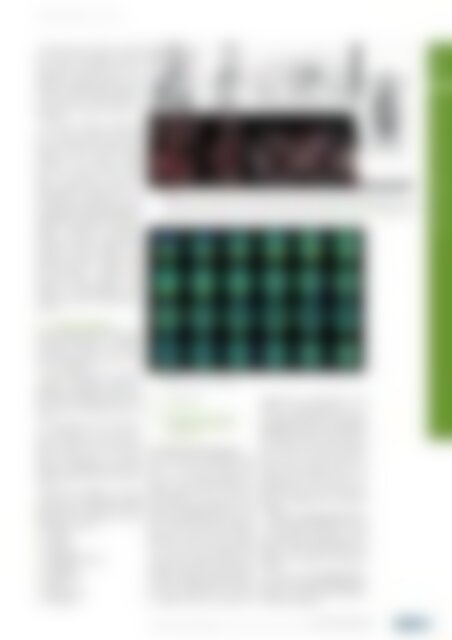atw International Journal for Nuclear Power | 04.2020
Title atw - International Journal for Nuclear Power | 04.2020 Description Ever since its first issue in 1956, the atw – International Journal for Nuclear Power has been a publisher of specialist articles, background reports, interviews and news about developments and trends from all important sectors of nuclear energy, nuclear technology and the energy industry. Internationally current and competent, the professional journal atw is a valuable source of information. www.nucmag.com
Title
atw - International Journal for Nuclear Power | 04.2020
Description
Ever since its first issue in 1956, the atw – International Journal for Nuclear Power has been a publisher of specialist articles, background reports, interviews and news about developments and trends from all important sectors of nuclear energy, nuclear technology and the energy industry. Internationally current and competent, the professional journal atw is a valuable source of information.
www.nucmag.com
You also want an ePaper? Increase the reach of your titles
YUMPU automatically turns print PDFs into web optimized ePapers that Google loves.
<strong>atw</strong> Vol. 65 (2020) | Issue 4 ı April<br />
to each other and with an energy<br />
of 511 keV (rest energy of an electron).<br />
These two photons from one<br />
annihilation process lead to coincidences<br />
in opposing detectors. The<br />
spatial and time-related distribution<br />
of the detected decays allows to<br />
determine the spatial distribution of<br />
the tracer.<br />
The PET scanner contains of<br />
many photon detectors arranged<br />
in a ring around the gantry. The<br />
detector rings have 30-40 detector<br />
modules, each detector module<br />
consisting of 4-8 detector blocks<br />
that are equipped with several<br />
single crystals. This results in<br />
approximately 10,000 detector crystals<br />
which are arranged in a ring<br />
( scintillation counter) and coupled to<br />
approximately 1,000 photomultipliers<br />
enabling the detection of the annihilation<br />
radiation. Coincidences<br />
between two of these detectors are<br />
registered without physical collimation<br />
(in contrast to SPECT). This<br />
advantage results in higher count<br />
rates, efficiency, reso lution and<br />
ultimately image quality. Today<br />
instead of photo multipliers also<br />
technology based on semicon ductors<br />
is used.<br />
| Fig. 4.<br />
Example <strong>for</strong> the use of F-18-FDG in PET/CT in oncology. In the upper part the PET images show the distribution of the glucose<br />
metabolism. The lower part of the picture shows the PET images coregistered with diagnostic CT to allow morphologic evaluation and<br />
anatomic allocation of the functional images. The patient suffers from lesions with intensively storing thoracic and abdominal foci.<br />
ENVIRONMENT AND SAFETY 219<br />
3 <strong>Nuclear</strong> Medicine<br />
<strong>Nuclear</strong> medicine is based on the use<br />
of open radionuclides or radiopharmaceuticals<br />
(tracers) with rather<br />
short physical half-lives that emit α,<br />
b - , b + or γ radiation.<br />
Prior to injection they are usually<br />
coupled to substances suitable to<br />
depict organ specific processes such as<br />
perfusion, metabolism, organ functions,<br />
receptor availability and many<br />
more.<br />
A wide range of “in-vivo” measurement<br />
methods can be used to<br />
assess the function of organs and/or<br />
organ systems, and to track the<br />
effects of treatment (e.g. chemotherapy<br />
or radiotherapy) and a range<br />
of physiological processes within the<br />
body.<br />
Functional imaging in nuclear<br />
medicine is an interdisciplinary field<br />
which supports almost all medical<br />
disciplines. In particular, but not<br />
exclusively, these are:<br />
p Oncology<br />
p Urology<br />
p Gynecology<br />
p Otorhinolaryngology<br />
p Cardiology<br />
p Dermatology<br />
p Surgery<br />
p Endocrinology<br />
p Neurology<br />
| Fig. 5.<br />
Use of F-18-FDG in PET/CT (neurology).<br />
3.1 Diagnostics<br />
3.1.1 Radiopharmaceuticals<br />
in daily routine used<br />
<strong>for</strong> PET/CT<br />
F-18-FDG (fluorodeoxyglucose)<br />
This is the most commonly used<br />
tracer <strong>for</strong> PET. Tumor cells often<br />
have an increased affinity <strong>for</strong><br />
glucose. Like the unlabeled physiological<br />
glucose FDG is taken up<br />
intracellularly by the glucose transporter<br />
and phos phorylated by the<br />
glucose-6-phosphatase enzym, however,<br />
then the further metabolic<br />
pathway is blocked <strong>for</strong> FDG. There<strong>for</strong>e<br />
FDG is <strong>for</strong> some time trapped<br />
in the cell and the retention rate<br />
in the tissue is mainly related to the<br />
number and activity of the glucose<br />
transport. Similar mechanisms apply<br />
to various inflammatory cells. However,<br />
keep in mind that not all types<br />
of tumors and not all types of<br />
inflammation are FDG positive. F-18<br />
labeled fluorodeoxy glucose (b + )<br />
is a positron emitter, the coincident<br />
gamma radiation of the corres ponding<br />
annihilation process can be detected<br />
by the PET scanner. State-of-the-art<br />
PET scanners are always combined<br />
with a CT unit. PET and CT are<br />
consecutively acquired without the<br />
patient moving between the two<br />
examinations. This achieves the<br />
greatest possible spatial corre lation<br />
between functional and structural<br />
imaging.<br />
For most oncological indications,<br />
a hybrid scanner (PET/CT) is used<br />
<strong>for</strong> whole-body acquisitions in 3D<br />
mode. The quantitative SUV ( standard<br />
uptake value) determination can<br />
objec tify the degree of metabolic<br />
activity.<br />
In the case of neurological disorders,<br />
such as some neurodegenerative<br />
diseases, the FDG brain metabolism<br />
can also be examined.<br />
Environment and Safety<br />
Excursus to the World of <strong>Nuclear</strong> Medicine ı Andreas Schmidt, Klaus Tatsch, Beate Pfeiffer, Verena Störzbach and Maximilian Kauth

















